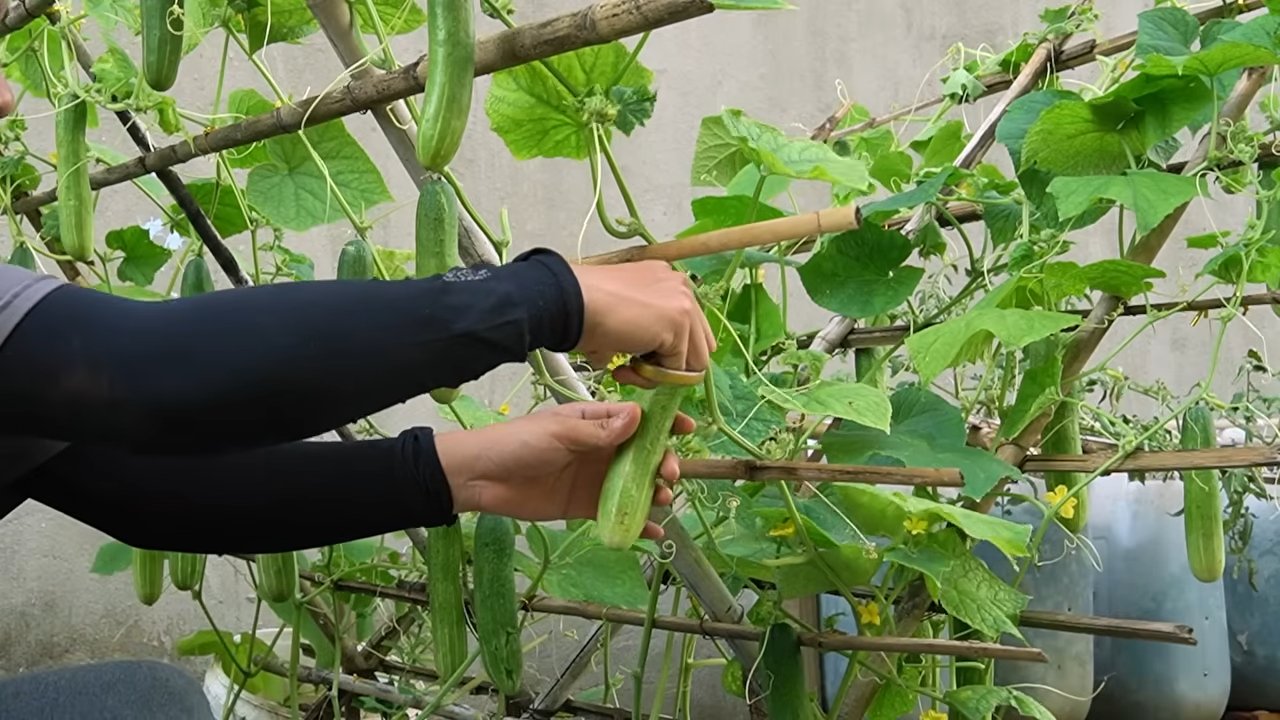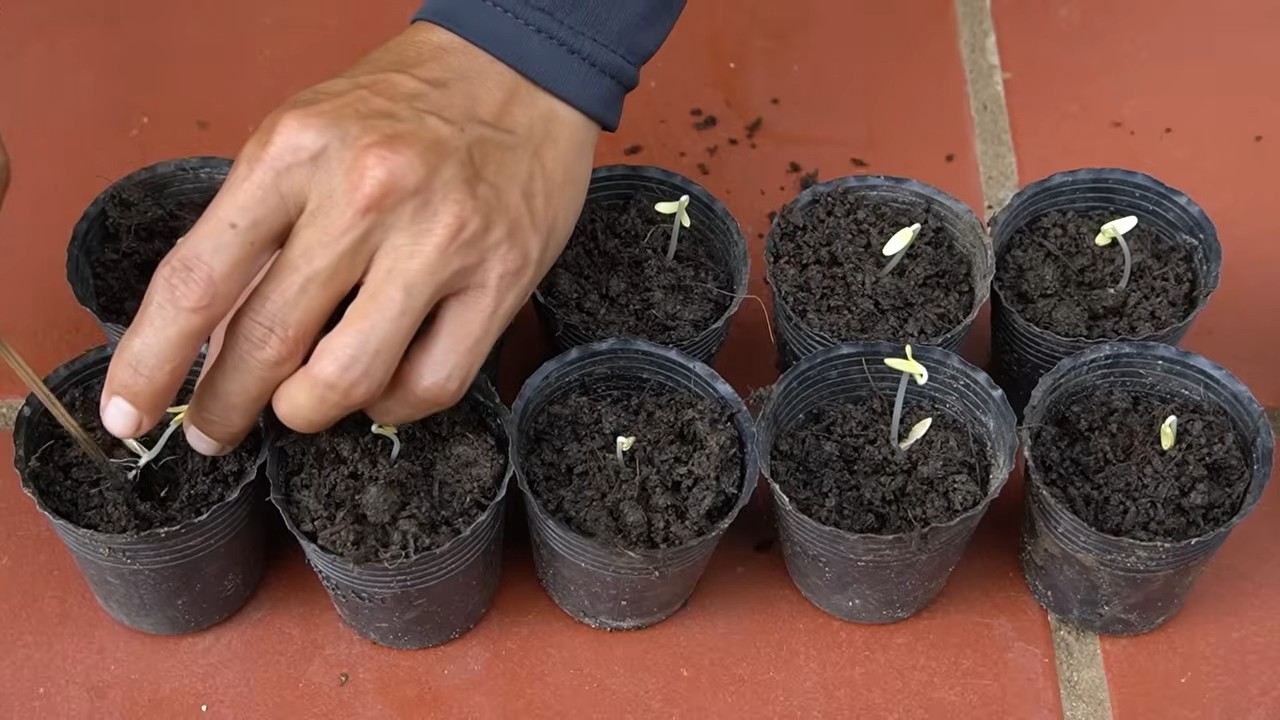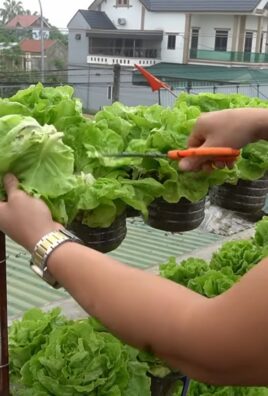Grow Giant Cucumbers and impress your neighbors with vegetables so large, they’ll be the talk of the town! Have you ever dreamed of harvesting cucumbers so enormous they could practically feed a family for a week? Well, you’re in the right place. This isn’t just about growing cucumbers; it’s about cultivating behemoths, and I’m here to share my secrets to achieving just that.
The quest for larger-than-life vegetables isn’t new. Throughout history, gardeners have strived to push the boundaries of what’s possible, often driven by friendly competition and the sheer joy of witnessing nature’s abundance. Think of county fairs and agricultural shows, where bragging rights are earned with the biggest pumpkin or the longest zucchini. Now, it’s your turn to join the ranks of these horticultural heroes!
But why bother with giant cucumbers? Beyond the novelty, growing these oversized veggies can be incredibly rewarding. They’re perfect for pickling in large batches, creating impressive displays, or simply enjoying the satisfaction of nurturing something truly extraordinary. Plus, learning the techniques to grow giant cucumbers will undoubtedly improve your overall gardening skills, leading to healthier and more productive plants across the board. So, let’s dive into the DIY tricks and hacks that will transform your cucumber patch into a land of giants!

Grow Giant Cucumbers: My Secrets to Bumper Crops!
Okay, cucumber lovers, gather ’round! I’m about to spill all my secrets for growing truly GIANT cucumbers. We’re talking prize-winning, county-fair-worthy behemoths. It’s not as hard as you might think, but it does take a little planning and dedication. So, let’s get started!
Choosing the Right Variety
First things first, you can’t grow a giant cucumber from just any old seed. You need to choose a variety specifically bred for size. Here are a few of my favorites:
* ‘Diva’: This is a parthenocarpic variety, meaning it doesn’t need pollination to produce fruit. This is great if you have limited pollinators in your area. They are also known for their smooth skin and delicious flavor, even when large.
* ‘Boothby’s Blonde’: An heirloom variety with a unique pale yellow skin. They can grow quite large and have a mild, sweet flavor.
* ‘Armenian Cucumber’ (also known as ‘Yard Long Cucumber’): While technically a melon, it’s used like a cucumber and can grow incredibly long – sometimes up to three feet!
* ‘Chinese Slangen’: This is a long, slender cucumber that can reach impressive lengths. It has a slightly ribbed skin and a crisp, refreshing flavor.
Important Tip: Always buy your seeds from a reputable source to ensure you’re getting the real deal.
Preparing the Soil: The Foundation for Giants
Cucumbers are heavy feeders, meaning they need a lot of nutrients to grow. So, preparing your soil is absolutely crucial.
* Sunlight: Cucumbers need at least 6-8 hours of direct sunlight per day. Choose a location that gets plenty of sun.
* Soil Type: They prefer well-drained, fertile soil with a pH between 6.0 and 7.0.
* Amendments: This is where the magic happens! I like to amend my soil with plenty of organic matter, such as:
* Composted Manure: This is a fantastic source of nutrients and helps improve soil structure.
* Compost: Another great way to add organic matter and improve drainage.
* Worm Castings: These are packed with beneficial microbes and nutrients.
* Bone Meal: Provides phosphorus, which is essential for root development.
* Kelp Meal: A great source of potassium and trace minerals.
Step-by-Step Soil Preparation:
1. Clear the Area: Remove any weeds, rocks, or debris from the planting area.
2. Dig Deep: Dig down at least 12 inches. This will loosen the soil and allow the roots to penetrate easily.
3. Amend the Soil: Mix in your chosen amendments thoroughly. I usually use a garden fork to work everything in. Aim for a ratio of about 1/3 amendment to 2/3 soil.
4. Rake Smooth: Rake the soil smooth and level.
5. Water Well: Water the soil thoroughly to help settle everything in.
Starting Your Seeds: Indoors or Out?
You can either start your cucumber seeds indoors or direct sow them in the garden. I prefer to start them indoors, especially if you have a short growing season.
* Starting Indoors:
* Timing: Start your seeds about 3-4 weeks before the last expected frost.
* Containers: Use peat pots or biodegradable pots. Cucumbers don’t like to have their roots disturbed, so these pots can be planted directly into the ground.
* Soil: Use a good quality seed starting mix.
* Planting: Plant 2-3 seeds per pot, about 1/2 inch deep.
* Watering: Keep the soil consistently moist, but not soggy.
* Light: Provide plenty of light. A sunny windowsill or grow lights will work.
* Hardening Off: Before transplanting your seedlings outdoors, you need to harden them off. This means gradually exposing them to outdoor conditions over a period of about a week. Start by placing them in a sheltered location for a few hours each day, gradually increasing the amount of time they spend outdoors.
* Direct Sowing:
* Timing: Wait until the soil has warmed up to at least 60°F (15°C).
* Planting: Plant seeds about 1 inch deep and 6-12 inches apart.
* Watering: Keep the soil consistently moist until the seeds germinate.
Transplanting and Trellising: Giving Your Cucumbers Room to Grow
Once your seedlings have developed a few true leaves (the leaves that appear after the initial seed leaves), it’s time to transplant them into the garden.
Step-by-Step Transplanting:
1. Choose a Cloudy Day: Transplanting on a cloudy day will help reduce stress on the seedlings.
2. Dig Holes: Dig holes that are slightly larger than the pots your seedlings are in. Space the holes about 2-3 feet apart, depending on the variety.
3. Remove Seedlings: Gently remove the seedlings from their pots. If you’re using peat pots, you can plant the entire pot. Just make sure to tear off the top edge of the pot to allow the roots to escape.
4. Plant Seedlings: Place the seedlings in the holes and backfill with soil.
5. Water Well: Water the seedlings thoroughly.
6. Mulch: Apply a layer of mulch around the plants to help retain moisture and suppress weeds. I like to use straw or wood chips.
Trellising:
Cucumbers are vines, so they need something to climb on. Trellising not only saves space but also improves air circulation, which helps prevent diseases.
* Types of Trellises: There are many different types of trellises you can use, such as:
* A-Frame Trellises: These are easy to build and provide plenty of support.
* Vertical Trellises: These are great for small spaces.
* Cattle Panels: These are sturdy and can support heavy vines.
* Training the Vines: As the cucumber vines grow, you’ll need to train them to climb the trellis. Gently guide the vines up the trellis and tie them in place with twine or plant clips.
Watering and Fertilizing: Keeping Your Cucumbers Happy
Cucumbers need consistent watering, especially during hot weather. Aim to water deeply and regularly, providing about 1 inch of water per week.
* Watering Tips:
* Water Early in the Morning: This allows the foliage to dry before nightfall, which helps prevent diseases.
* Water at the Base of the Plant: Avoid wetting the foliage as much as possible.
* Use a Soaker Hose or Drip Irrigation: These methods deliver water directly to the roots, which is more efficient and helps prevent diseases.
* Fertilizing:
* Side-Dress with Compost: Every few weeks, side-dress your cucumber plants with compost.
* Liquid Fertilizer: You can also use a liquid fertilizer, such as fish emulsion or seaweed extract. Follow the instructions on the label.
* Avoid Over-Fertilizing: Too much fertilizer can lead to excessive foliage growth and fewer fruits.
Pest and Disease Control: Protecting Your Investment
Cucumbers are susceptible to a few pests and diseases. Here are some common problems and how to deal with them:
* Cucumber Beetles: These beetles can damage foliage and spread diseases.
* Control: Handpick beetles, use row covers, or spray with neem oil.
* Squash Bugs: These bugs suck the sap from plants and can cause them to wilt and die.
* Control: Handpick bugs and eggs, use row covers, or spray with insecticidal soap.
* Powdery Mildew: This fungal disease causes a white, powdery coating on the leaves.
* Control: Improve air circulation, water early in the morning, and spray with a fungicide.
* Downy Mildew: This fungal disease causes yellow spots on the leaves.
* Control: Improve air circulation, water early in the morning, and spray with a fungicide.
Important Tip: Regularly inspect your plants for pests and diseases. The sooner you catch a problem, the easier it will be to control.
Harvesting: The Moment of Truth!
The time to harvest your giant cucumbers will depend on the variety you’re growing. Generally, you’ll want to harvest them when they’re still young and tender. Overripe cucumbers can become bitter

Conclusion
So, there you have it! Unlocking the secret to growing truly giant cucumbers isn’t about magic beans or complicated rituals. It’s about understanding the plant’s needs, providing the right environment, and employing a few simple, yet effective, DIY tricks. This method, focusing on nutrient-rich soil, strategic pruning, and consistent watering, is a game-changer for any gardener aspiring to cultivate impressive, prize-winning cucumbers.
Why is this DIY trick a must-try? Because it empowers you to take control of your cucumber’s growth trajectory. Instead of relying solely on commercial fertilizers or hoping for the best, you’re actively shaping the outcome. You’re creating a customized environment that caters specifically to the demands of a rapidly growing, fruit-producing vine. The satisfaction of harvesting a cucumber that dwarfs anything you’ve ever seen before is unparalleled. It’s a testament to your dedication, your understanding of plant biology, and your willingness to experiment.
But the journey doesn’t end here! Feel free to experiment with variations on this method. Try different types of organic fertilizers, like compost tea or worm castings, to see which yields the best results in your specific soil conditions. Consider using a trellis system that allows for optimal sunlight exposure and air circulation, further promoting healthy growth. You could even explore different cucumber varieties known for their potential to grow large, such as the ‘Armenian’ or ‘Boothby’s Blonde’ cucumber.
Remember, growing giant cucumbers is a learning process. Don’t be discouraged if your first attempt doesn’t produce a record-breaking specimen. Each season brings new opportunities to refine your technique and learn from your experiences. The key is to stay observant, adapt to the changing conditions, and never stop experimenting.
We wholeheartedly encourage you to try this DIY trick and witness the remarkable results for yourself. Imagine the awe and admiration of your friends and neighbors when they see the colossal cucumbers you’ve grown! More importantly, imagine the delicious meals you can create with these bountiful harvests.
And most importantly, we want to hear about your journey! Share your experiences, your successes, and even your challenges in the comments below. What worked best for you? What obstacles did you encounter? Your insights can help other gardeners achieve their own giant cucumber dreams. Let’s build a community of passionate growers, sharing knowledge and inspiring each other to push the boundaries of what’s possible in the garden. Let’s all learn how to grow giant cucumbers together!
Frequently Asked Questions (FAQ)
What kind of soil is best for growing giant cucumbers?
The ideal soil for growing giant cucumbers is rich, well-draining, and loamy. It should be packed with organic matter to provide the necessary nutrients for rapid growth. Before planting, amend your soil with plenty of compost, aged manure, or other organic amendments. A slightly acidic to neutral pH (around 6.0 to 7.0) is also preferred. Consider getting a soil test to determine your soil’s current pH and nutrient levels, and adjust accordingly. Good drainage is crucial to prevent root rot, which can severely hinder growth. If your soil is heavy clay, consider adding sand or perlite to improve drainage.
How often should I water my cucumber plants?
Consistent watering is essential for growing giant cucumbers. These plants are heavy feeders and drinkers, especially during the fruiting stage. Aim to water deeply and regularly, keeping the soil consistently moist but not waterlogged. The frequency will depend on your climate and soil type, but generally, you should water at least every other day, and possibly daily during hot, dry periods. A good rule of thumb is to water when the top inch of soil feels dry to the touch. Consider using a soaker hose or drip irrigation system to deliver water directly to the roots, minimizing water loss through evaporation and reducing the risk of fungal diseases.
How much sunlight do cucumber plants need?
Cucumber plants require at least 6-8 hours of direct sunlight per day to thrive and produce large fruits. Choose a planting location that receives ample sunlight throughout the day. If you live in a particularly hot climate, some afternoon shade may be beneficial to prevent the plants from overheating. Insufficient sunlight can lead to stunted growth, reduced fruit production, and smaller cucumbers.
What kind of fertilizer should I use?
Giant cucumbers require a steady supply of nutrients to support their rapid growth. Start with a balanced fertilizer (e.g., 10-10-10) at planting time, following the instructions on the label. Once the plants start producing flowers and fruits, switch to a fertilizer that is higher in phosphorus and potassium, which are essential for fruit development. You can also supplement with organic fertilizers like compost tea, fish emulsion, or bone meal. Avoid over-fertilizing, as this can lead to excessive foliage growth at the expense of fruit production. Regular soil testing can help you determine the specific nutrient needs of your plants.
How do I prune my cucumber plants to encourage larger fruits?
Pruning is a crucial step in growing giant cucumbers. The goal is to direct the plant’s energy towards producing fewer, but larger, fruits. Remove any suckers (small shoots that grow from the base of the plant) and any yellowing or diseased leaves. You can also pinch off some of the smaller, less vigorous fruits to allow the plant to focus its energy on the remaining ones. Some growers even limit the plant to just one or two fruits per vine to maximize their size. Regular pruning also improves air circulation, reducing the risk of fungal diseases.
How do I protect my cucumber plants from pests and diseases?
Cucumber plants are susceptible to various pests and diseases, including cucumber beetles, squash bugs, aphids, powdery mildew, and downy mildew. Regularly inspect your plants for signs of infestation or disease. Use organic pest control methods, such as insecticidal soap, neem oil, or diatomaceous earth, to control pests. To prevent fungal diseases, ensure good air circulation, avoid overhead watering, and apply a fungicide if necessary. Crop rotation can also help to reduce the buildup of pests and diseases in the soil.
How long does it take to grow a giant cucumber?
The time it takes to grow a giant cucumber depends on several factors, including the variety, growing conditions, and your level of care. Generally, it takes about 50-70 days from planting to harvest. However, to grow a truly giant cucumber, you may need to allow it to grow for a longer period, even up to 90 days or more. Keep a close eye on the fruit and harvest it when it reaches the desired size and maturity.
What are some cucumber varieties known for growing large?
Several cucumber varieties are known for their potential to grow large. Some popular choices include:
* Armenian Cucumber: These cucumbers can grow up to 2-3 feet long and have a mild, sweet flavor.
* Boothby’s Blonde Cucumber: This heirloom variety produces large, pale yellow cucumbers with a crisp texture.
* Chinese Slangen Cucumber: These cucumbers can grow up to 18 inches long and have a slightly curved shape.
* A long English cucumber variety.
Experiment with different varieties to find one that suits your taste and growing conditions.
Can I grow giant cucumbers in a container?
Yes, you can grow giant cucumbers in a container, but you’ll need a large container (at least 20 gallons) to accommodate the plant’s extensive root system. Choose a container with good drainage and fill it with a high-quality potting mix. Provide a trellis or other support for the vines to climb. Water and fertilize regularly, as container-grown plants tend to dry out and deplete nutrients more quickly than those grown in the ground.
What if my cucumber plant produces flowers but no fruit?
This is a common problem known as blossom drop. It can be caused by several factors, including:
* High temperatures: Temperatures above 90°F (32°C) can interfere with pollination.
* Insufficient pollination: Cucumbers require pollination to set fruit. Ensure that there are plenty of pollinators (bees, butterflies, etc.) in your garden. You can also hand-pollinate the flowers by transferring pollen from the male flowers to the female flowers using a small brush.
* Nutrient deficiencies: A lack of phosphorus or potassium can also cause blossom drop.
* Water stress: Inconsistent watering can also lead to blossom drop.
Address these potential issues to improve fruit set.




Leave a Comment